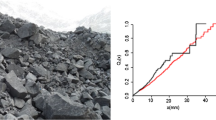Abstract
VARIOUS measures of the size of irregularly shaped particles as seen in profile under the microscope have been used, chosen according to their theoretical significance or practical ease of measurement. These include, using Heywood‘s notation1,2 : (i) the diameter of the circle of equal area, d ; (ii) the diameter of the circle of equal perimeter, D ; (iii) the length of line bisecting the profile area (Martin‘s statistical diameter3), M ; and (iv) the perpendicular distance between parallel tangents touching opposite sides of the profile (Feret‘s statistical diameter4), F. M and F are determined for randomly oriented particles, thus giving an average value over all possible orientations. d is usually regarded as the ideal measure of particles seen in profile, but is somewhat difficult to determine experimentally with precision. It is, however, common practice when sizing very small particles to estimate d visually by comparing them with standard reference circles on a Patterson and Cawood or similar type of eyepiece graticule5,6. M and F are convenient to measure in practice with aid of an eyepiece scale or filar micrometer, and have been extensively used by various Workers. D, or rather the ratio D/d, termed by Heywood1 the ‘contour ratio', and its reciprocal called the ‘degree of circularity' by Wadell7, have been used in discussing the shape and hydrodynamical properties of particles. For these purposes D has usually been determined by direct perimeter measurement of the projected images of particles. It does not appear to have been adopted intentionally in any work known to me as a direct single measure of particle size.
Similar content being viewed by others
References
Heywood, H., Proc. Inst. Mech. Eng., 125, 383 (1933).
Heywood, H., Bull. Inst. Min. and Met., No. 477 (March 1946).
Martin, G., Blyth, C. E., and Tongue, H., Trans. Brit. Ceramic Soc., 23, 61 (1923–24).
Feret, L. R., Assoc. Internat. pour l‘Essai des Mat., Zurich, 1931, 2, Group D.
Patterson, H. S., and Cawood, W., Trans. Farad. Soc., 32, 1084 (1936).
Fairs, G. L., Chem. Ind., 62, 1374 (1943).
Wadell, H., J. Frank. Inst., 217, 459 (1934).
Rose, H. E., and Lloyd, H. B., J. Soc. Chem. Ind., 65, 52 (1946).
Cauchy, A., C.R. Acad. Sci., Paris, 13, 1060 (1841).
Vouk, V. (see following communication).
Author information
Authors and Affiliations
Rights and permissions
About this article
Cite this article
WALTON, W. Feret‘s Statistical Diameter as a Measure of Particle Size. Nature 162, 329–330 (1948). https://doi.org/10.1038/162329b0
Issue Date:
DOI: https://doi.org/10.1038/162329b0
- Springer Nature Limited
This article is cited by
-
Settling velocities of coarse organic solids
Scientific Reports (2023)
-
Identifying Critical Defect Sizes From Pore Clusters in Nickel-based Superalloys Using Automated Analysis and Casting Simulation
Metallurgical and Materials Transactions A (2023)
-
Caveolin-1 dolines form a distinct and rapid caveolae-independent mechanoadaptation system
Nature Cell Biology (2023)
-
Modulation of thermometric performance of single-band-ratiometric luminescent thermometers based on luminescence of Nd3+ activated tetrafluorides by size modification
Scientific Reports (2022)
-
Effect of mesoscale internal structure on effective thermal conductivity of anisotropic geomaterials
Acta Geotechnica (2022)





